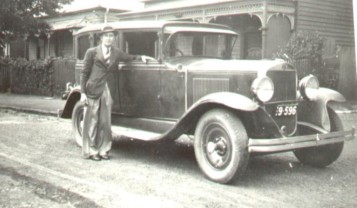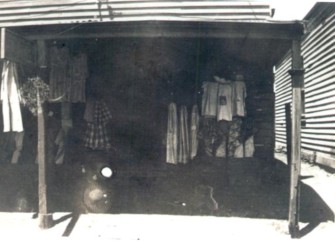


As farming continued to make advances and become more mechanised in the Mallee in the 1920s there arose a greater need for machinery agents and Stubby through the '20s and '30s became a commission agent for several agricultural implement makers including Mitchell & Co and British Australasian Tractors selling Vickers tractors. Sales for 1923 included Big E Harvesters, separators and sheaf carriers at £7, £1 and £1 commission respectively. Spare parts were also stocked and the building formerly used for the storage of chaff and oats was utilised as a Machinery Duplicate and Separator Depot. Duplicates and drills from Mitchell & Co to June 30, 1926 amounted to £6/15/2 while sales of chaff cutters, combines, harrows and plows earned £38/12/9 commission. Another agency taken on in 1930 was for District Messengers Pty. Ltd. for the delivery of circulars and samples to households in the district. Sea Lake at that time boasted a population of 700 and 165 households. Mr & Mrs Stubbs' daughter Audrey had completed her schooling in 1928 and joined her father in the business. With the expansion of the business throughout the '20s and the desire of Mrs Stubbs to take a more active role, it was decided in 1930 to demolish the now dilapidated shops and baker's oven at 68-72 Stubby's Store, circa 1918, showing obvious signs of disrepair. Best Street and W. A. Hill, Builder of Sea Lake was commissioned to erect 3 concrete shops together with a dwelling to be attached to the bakery and rebuild the oven at a total cost of £1424/16/-. Assisting Bill Hill was a young newcomer to Sea Lake, George Foster. The new building was begun in March 1930 and completed by January 1931 and the newsagency became a separate business in its own right occupying the middle larger shop. The east shop became the office and store for the commission agency and the west shop remained the bakery. The early 1930s are remembered for the worst depression ever to sweep the world. With the depression came the controversial Rural Debt adjustment and like all businessmen Stubby lost a lot of money when all farmers debts were declared void. Only one farmer returned after the depression was over to pay his old debt. In 1932 with the introduction of Doug House's Pioneer Bus service between Bendigo and Sea Lake service to customers improved, daily papers now arrived in town at lunchtime, a vast improvement over the rail service, although magazines and the Weekly Times were still delivered by train. The Bendigo Advertiser now became available as were sporting goods, cordials, sheet music and gardening needs such as packet seeds. Cyclops and Pynors began supplying toys and Valentines introduced a range of greeting cards. Jewellery was also stocked and Stubby continued with his machinery agency. In August 1934 Belle Cairns and Mary McGregor were employed at £2/10/- and £1/7/- per fortnight. Electricity cost £3/12/3, telephone £5, letter box hire was 10/- and a wireless licence cost £1/1/-. Motor registration on the new Graham Paige was £7/12/- and a drivers licence cost 5/-. Roma Beilby entered the Stubbs employ in 1936 at £1 per fortnight. She was assisted throughout the remainder of the decade by Bernice Fawcett and Isabel McClelland. According to Roma (later Mrs I. Giddings) late night shopping was available for customers on Friday night until 9 pm but was sparsely attended during the winter months! Saturday morning trade continued until the bus arrived with the daily papers, often late due to the poor quality of the roads of the day. Mail runs then had to be prepared to Tyrrell, Green Lake and Myall before closing. Len Lloyd and the Stubbs' Graham Paige while on holidays, thought to be PortIand. |